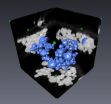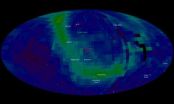(Press-News.org) WEST LAFAYETTE, Ind. – Researchers are improving the performance of technologies ranging from medical CT scanners to digital cameras using a system of models to extract specific information from huge collections of data and then reconstructing images like a jigsaw puzzle.
The new approach is called model-based iterative reconstruction, or MBIR.
"It's more-or-less how humans solve problems by trial and error, assessing probability and discarding extraneous information," said Charles Bouman, Purdue University's Michael and Katherine Birck Professor of Electrical and Computer Engineering and a professor of biomedical engineering.
MBIR has been used in a new CT scanning technology that exposes patients to one-fourth the radiation of conventional CT scanners. In consumer electronics, a new camera has been introduced that allows the user to focus the picture after it has been taken.
"These innovations are the result of 20 years of research globally to develop iterative reconstruction," Bouman said. "We are just scratching the surface. As the research community builds more accurate models, we can extract more information to get better results."
In medical CT scanners, the reduction of radiation exposure is due to increased efficiency achieved via the models and algorithms. MBIR reduces "noise" in the data, providing greater clarity that allows the radiologist or radiological technician to scan the patient at a lower dosage, Bouman said.
"It's like having night-vision goggles," he said. "They enable you to see in very low light, just as MBIR allows you to take high-quality CT scans with a low-power X-ray source."
Researchers also have used the approach to improve the quality of images taken with an electron microscope. New findings are detailed in a research paper being presented during the Electronic Imaging 2013 conference in San Francisco this week.
Traditionally, imaging sensors and software are designed to detect and measure a particular property. The new approach does the inverse, collecting huge quantities of data and later culling specific information from this pool of information using specialized models and algorithms.
"We abandon the idea of purity – collecting precisely what we need," Bouman said. "Instead, let's take all the measurements we possibly can and then later extract what we want. This increases the envelope of what you can do enormously."
Purdue, the University of Notre Dame and GE Healthcare used MBIR to create Veo, a new CT scanning technology that enables physicians to diagnose patients with high-clarity images at previously unattainable low radiation dose levels. The technology has been shown to reduce radiation exposure by 78 percent.
"If you can get diagnostically usable scans at such low dosages this opens up the potential to do large-scale screening for things like lung cancer," Bouman said. "You open up entirely new clinical applications because the dosage is so low."
A CT scanner is far better at diagnosing disease than planar X-rays because it provides a three-dimensional picture of the tissue. However, conventional CT scanners emit too much radiation to merit wider diagnostic use.
"But as the dosage goes down, the risk-benefit tradeoff for screening will become much more favorable," Bouman said. "For electron microscopy, the principle advantage is higher resolutions, but there is also some advantage in reduction of electron dosage, which can damage the sample."
The research to develop Veo has been a team effort with Ken Sauer, an associate professor of electrical engineering at Notre Dame, in collaboration with Jean-Baptiste Thibault, Jiang Hsieh and Zhou Yu. Thibault and Yu worked on the technology as graduate assistants under Bouman and Sauer and both currently work for GE Healthcare.
"And, there are lots of other people doing similar and related research at other universities and research labs around the world," Bouman said. "Ultimately, 3-D X-ray CT images might require little more dosage than old-fashion planar chest X-rays. This would allow CT to be used for medical screening without significant adverse effects."
In the electron microscope research, MBIR was used to take images of tiny beads called aluminum nanoparticles.
"We are getting reconstruction quality that's dramatically better than was possible before, and we think we can improve it even further," Bouman said.
Improved resolution could help researchers design the next generation of nanocomposites for applications such as fuel cells and transparent coatings.
The paper was authored by Purdue doctoral student Singanallur Venkatakrishnan; U.S. Air Force Research Laboratory researchers Lawrence Drummy and Jeff Simmons; Michael Jackson, a researcher from BlueQuartz Software; Carnegie Mellon University researcher Marc De Graef; and Bouman. A tutorial article also appeared in January in the journal Current Radiological Reports.
The models and algorithms in MBIR apply probability computations to extract the correct information, much as people use logical assumptions to draw conclusions.
"You search all possible data to find what you are looking for," Bouman said. "This is how people solve problems. You saw Bob yesterday at the store; you wonder where he was coming from. Well, you determine that he was probably coming from work because you have some probabilistic models in your mind. You know he probably wasn't coming from San Francisco because Bob doesn't go to San Francisco very often, etc."
MBIR also could bring more affordable CT scanners for airport screening. In conventional scanners, an X-ray source rotates at high speed around a chamber, capturing cross section images of luggage placed inside the chamber. However, MBIR could enable the machines to be simplified by eliminating the need for the rotating mechanism.
Future research includes work to use iterative reconstruction to study materials. Purdue is part of a new Multi-University Research Initiative funded by the U.S. Air Force and led by De Graef. Researchers will use the method to study the structure of materials, work that could lead to development of next-generation materials.
INFORMATION:
Writer: Emil Venere, 765-494-4709, venere@purdue.edu
Source: Charles Bouman, 765-494-0340, Bouman@purdue.edu
Related website:
Electronic Imaging 2013: http://spie.org/electronic-imaging.xml
IMAGE CAPTION:
Researchers are improving the performance of technologies ranging from medical CT scanners to digital cameras using a system of models to extract specific information from huge collections of data and then reconstructing images like a jigsaw puzzle. Here, the method is used to create a high-resolution 3-D electron microscopy reconstruction of aluminum nanoparticles, aiding efforts to design nanocomposites for applications ranging from fuel cells to transparent coatings. (Purdue University, U.S. Air Force Research Laboratory and Carnegie Mellon University)
A publication-quality image is available at http://news.uns.purdue.edu/images/2013/bouman-mbir.jpg.
ABSTRACT
Model Based Iterative Reconstruction for Bright Field Electron Tomography
Singanallur V. Venkatakrishnan a, Lawrence F. Drummy b, Marc De Graef c, Jeff P. Simmons b, and Charles A. Bouman a
a Purdue University; b Air Force Research Lab; c Carnegie Mellon University
Bright Field (BF) electron tomography (ET) has been widely used in the life sciences to characterize biological specimens in 3-D. While BF-ET is the dominant modality in the life sciences, it has been generally avoided in the physical sciences due to anomalous measurements in the data due to a phenomenon called "Bragg scatter" - visible when crystalline samples are imaged. These measurements cause undesirable artifacts in the reconstruction when the typical algorithms such as Filtered Back Projection (FBP) and Simultaneous Iterative Reconstruction Technique (SIRT) are applied to the data. Model based iterative reconstruction (MBIR) provides a powerful framework for tomographic reconstruction that incorporates a model for data acquisition, noise in the measurement and a model for the object to obtain reconstructions that are qualitatively superior and quantitatively accurate. In this paper we present a novel MBIR algorithm for BF-ET which accounts for the presence of anomalous measurements from Bragg scatter in the data during the iterative reconstruction. Our method accounts for the anomalies by formulating the reconstruction as minimizing a cost function which rejects measurements that deviate significantly from the typical Beer's law model widely assumed for BF-ET. Results on simulated as well as real data show that our method can dramatically improve the reconstructions compared to FBP and MBIR without anomaly rejection, suppressing the artifacts due to the Bragg anomalies.
New modeling approach transforms imaging technologies
2013-02-06
ELSE PRESS RELEASES FROM THIS DATE:
Obesity treatment breakthrough described in EurekAlert!'s No. 1 most-visited news release in 2012
2013-02-06
EurekAlert!'s most-viewed news release from 2012 focused on a breakthrough in the treatment of obesity and related diseases using a combination of hormones, tested in mice, that resulted in weight loss and lowered blood sugar without negative side effects.
The theme of obesity was prominent in three other most-viewed news releases on EurekAlert! during 2012.. Other topics were mental health, neuroscience, marine conservation, human behavioral science, and progress toward a male contraceptive pill.
EurekAlert! is the global science news service operated by the American ...
Scientists debate CDC recommendations during meningitis outbreak
2013-02-06
A pair of commentaries to appear in an upcoming issue of the journal Antimicrobial Agents and Chemotherapy highlight a debate within the public health community surrounding Centers for Disease Control and Prevention (CDC) recommendations for treatment of exposed individuals during last year's fungal meningitis outbreak. Manuscripts of the commentaries were published ahead of print today on the journal's webpage.
"I will try to offer sufficient documentation to show there are alternative approaches worthy of consideration," writes David A Stevens of Stanford University ...
Does probability come from quantum physics?
2013-02-06
Ever since Austrian scientist Erwin Schrodinger put his unfortunate cat in a box, his fellow physicists have been using something called quantum theory to explain and understand the nature of waves and particles.
But a new paper by physics professor Andreas Albrecht and graduate student Dan Phillips at the University of California, Davis, makes the case that these quantum fluctuations actually are responsible for the probability of all actions, with far-reaching implications for theories of the universe.
Quantum theory is a branch of theoretical physics that strives ...
Plants cut the mustard for basic discoveries in metabolism
2013-02-06
LA JOLLA, CA----You might think you have nothing in common with mustard except hotdogs. Yet based on research in a plant from the mustard family, Salk scientists have discovered a possible explanation for how organisms, including humans, directly regulate chemical reactions that quickly adjust the growth of organs. These findings overturn conventional views of how different body parts coordinate their growth, shedding light on the development of more productive plants and new therapies for metabolic diseases.
Metabolism refers to all the chemical reactions in the body ...
A major step forward in explaining the ribbon in space discovered by NASA's IBEX mission
2013-02-06
The vast edges of our solar system – the boundary at the edge of our heliosphere where material streaming out from the sun interacts with the galactic material – is essentially invisible. It emits no light and no conventional telescope can see it. However, particles from inside the solar system bounce off this boundary and neutral atoms from that collision stream inward. Those particles can be observed by instruments on NASA's Interstellar Boundary Explorer (IBEX). Since those atoms act as fingerprints for the boundary from which they came, IBEX can map that boundary in ...
UTHealth research shows American Indians at greater risk of suicide after alcohol intoxication
2013-02-06
HOUSTON – (February 5, 2013) – American Indians are at much greater risk of suicide after acute alcohol intoxication, according to a study led by researchers at The University of Texas Health Science Center at Houston (UTHealth).
The study examined the prevalence and social demographic correlates of suicide involving acute alcohol intoxication among United States ethnic minorities. Results will be published in the May 2013 issue of Alcoholism: Clinical & Experimental Research and are currently available at Early View.
"Some reviews suggest that people with alcohol ...
Air pollution primes children for asthma-related cockroach allergy
2013-02-06
An allergic reaction to cockroaches is a major contributor to asthma in urban children, but new research suggests that the insects are just one part of a more complex story. Very early exposure to certain components of air pollution can increase the risk of developing a cockroach allergy by age 7 and children with a common mutation in a gene called GSTM may be especially vulnerable.
Researchers at the Columbia Center for Children's Environmental Health at the Mailman School of Public Health published the findings, the first on this interplay of risk factors, in the February ...
Maternal exposure to outdoor air pollution associated with low birth weights worldwide
2013-02-06
Mothers who are exposed to particulate air pollution of the type emitted by vehicles, urban heating and coal power plants are significantly more likely to bear children of low birth weight, according to an international study led by co-principal investigator Tracey J. Woodruff, PhD, MPH, professor of obstetrics and gynecology and reproductive sciences at UC San Francisco along with Jennifer Parker, PhD, of the National Center for Health Statistics, Centers for Disease Control and Prevention.
The study, the largest of its kind ever performed, analyzed data collected from ...
Pirate-like flies connect symbiosis to diversity
2013-02-06
After a year of studying up close the symbiotic relationship between a mosquito-sized bug and a fungus, a Simon Fraser University biologist has advanced the scientific understanding of biological diversity.
Jeffrey Joy has discovered that symbiosis — a relationship between two or more organisms that can be parasitic or mutualistic — is as much the mother of biological diversity as predation and competition.
The Proceedings of the Royal Society of London Series B journal has just published the post-doctoral researcher's findings online. They advance Joy's previous ...
Jobs Difficult to Find for Those Over 55
2013-02-06
Jobs Difficult to Find for Those Over 55
Many employees continue to experience difficulties finding jobs in this tough economy. Unfortunately, research shows that those over the age of 55 seem to have an even greater struggle than most jobless Americans.
According to the AARP, unemployment rates for Americans 55 and older surged from 490,000 in 2000, to 2,114,000 in 2009. Reuters also reports that the number of workers over 55 struggling with long-term unemployment has more than doubled since 2007. In some cases, employee rights may come into play.
Both federal ...



